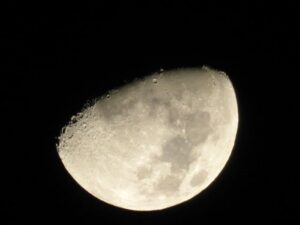By: MARGARET BROWN
THE THERMOMETER had remained at 27°C despite longer nights and when I mentioned to a friend “enough is enough, roll on winter”, being somewhat exhausted by the heat, it seems we have had a cooler than average summer and “what was I grumbling about”?
Not having been born a colonial, my personal thermostat was set at birth for more northern climates and, by the end of August, both the trees and I start to wilt. To complain about the weather is as British as fish and chips, and being of Yorkshire extract it is natural to keep in practice.
So, when I saw an advance weather forecast on September 4 promising rain the following day and a further week of cloud, my curmudgeonly soul rejoiced. Looking across the sun drenched hills, all colour bleached under a wide blue sky and not a cloud in sight hope almost died, but not quite, because among the rocky lifeless hills there were signs of autumn creeping in despite the dust laden Levanter.
For a few days, this hot dry wind from the Sahara Desert came in around noon, leaving fine grit everywhere. Having just had the house cleaned by courtesy of a neighbour whose weekly help had time to spare, the beautiful shine put on furniture and glass soon reverted to its habitual matt finish.
I’m tired of summer and wonder what lies ahead bearing in mind climate change and unseasonable surprises happening around the world. However, the rains came as promised: everything washed clean and the Algarve countryside was fragrant with herbs and eucalyptus.
Although nothing much stirs until the sun goes down, hill dwellers are going secretly about their business under cloak of darkness. Local toads are finding something to eat beside a rapidly disappearing local barragem, some of which are from this year’s spawn judging by the small black droppings lying about and the other night, a young toad stood transfixed by the car’s headlights as we crept up our drive. We had thought the large and warty adult that were once quite common round the house had moved elsewhere, which makes this all the more exciting.
Meanwhile, the swallows hatched this year have left together with a reduced number of swifts, neither of which has hatched many babies. A lone buzzard flew over the house yesterday, found a thermal and circled upward until it was lost from sight. The pair that nested nearby for the last two years have not been seen again.
Rats
Both flora and fauna have changed during the 21 years of our life in the valley, and at the time of writing, nothing but small flowering thistles lighten the dull and dusty vegetation. It will be interesting to see what emerges when enough rain has fallen to penetrate the cracked and stony ground.
Animals living in the hills are mostly nocturnal and shy but there is one unwelcome visitor, perhaps from a small holding, that has been giving us a lot of bother. While the Boss was unable to drive for a few weeks, his aged Citröen was left in the car port, and on his return he found that rats had been living in the engine leaving a scattering of acorns, leaves and droppings.
Plastic tops to various systems had been chewed together with several holes in the screen washer tank. A couple of days later when parked outside, we saw puddles beneath the radiator and, stopping now and then to top up the tank, we hastily made our way to the Citröen agent in Lagos. Spares being hard to come by, the car spent two days there and once home, a more thorough inspection was made under the bonnet. Inside the bulkhead, a nest was found from which a brown rat emerged. It must have been keeping a low profile while away from home. There were also traces of squatters in my Panda: pipes nibbled and other evidence, so as a precaution rat poison has been left in both cars.
Lack of spares for older vehicles ensures obsolescence and is a crafty means of turning over the market. In the past, this also applied to arthritic humans but, from the early 20th century, orthopaedic specialists have been searching for a way to replace damaged joints and since then a wide variety of designs and materials have been tested, improving all the time.
Mechanical spares
From the beginning it has been an engineering as much as a medical problem: research continues and, today, thousands of people who are now mobile might otherwise have been on the scrap heap like ancient cars.
Back in 1948, my mother was fitted with an artificial hip and it served her well for 22 years of vigorous living. Within a year, showing the same courage and faith in the medical profession, the Boss has been fitted with a new knee and hip in his left leg, and has a right knee replacement scheduled for January 2008.
If mechanical spares can be made to fit human skeletons anywhere in the world, why cannot automobile manufacturers use a little imagination and standardise certain basic car components to be interchangeable.
While looks seem to be almost as important as performance when choosing one’s personal run-about, surely under the sparkling finish and dazzling chrome some standardisation of parts that do not become obsolete should be possible.
























